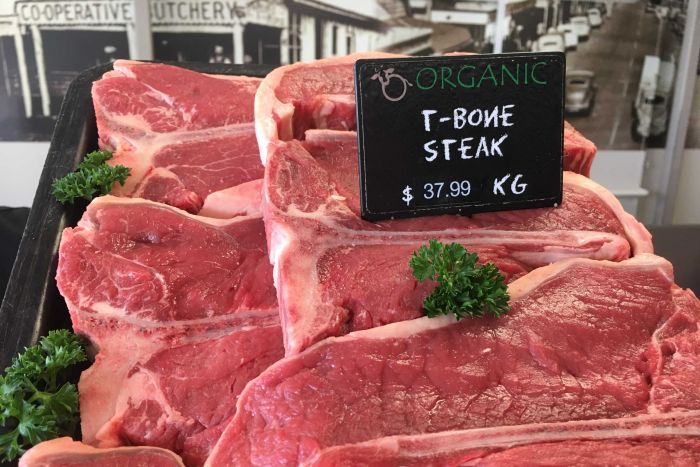
Australia's organic industry worth almost a billion dollars, as demand from high income earners soars
The demand for organic produce in Australia is seeing more farmers make the switch from conventional to organic farming.
That means the price of organic food in the supermarkets might soon start to drop slightly, although prices are expected to remain high for the foreseeable future.
Market analyst company IBISWorld said Australia’s organic industry was growing at an exponential rate, and valued it at $919 million.
Senior analyst Nick Tarrant said the sector grew 17 per cent in five years, due to a flood of farmers entering the market.
“That is mostly to do with the lengthy certification process, which can take three years for a farmer to convert to organic production methods,” he said.
“Over the past five years we have seen a lot of farmers finish that certification, which has pushed up production volumes and now there is a lot more product coming on to the market.”
The cost of organic products is high because organic food accounts for less than 5 per cent of Australia’s total food production by volume.
IBISWorld predicts the value of the organic industry could be $1.2 billion by 2022.
However, as the industry grows, that will mean the premium prices organic farmers are paid will begin to drop.
“The premium is about one-and-a-half to two times more for an organic product over an equivalent non-organic product,” Mr Tarrant said.
‘That is declining, mostly due to strong price competition as more farmers enter the market, but the margins are still significantly higher for organic farmers.
“When you increase the supply so much in one go the prices are going to fall, it’s not a huge fall, but it is falling marginally.”
Rising demand for organics due to health and animal welfare concerns
An organic butcher on Queensland’s Sunshine Coast said the price for organic beef kept rising, despite more livestock farmers making the switch to organic.
Charlie Everson from Sunshine Coast Organic Meats said consumers were demanding more organic meat products, and the industry could not keep up.
“I think we would all like the prices to drop a bit, that is the scariest thing about our industry at the moment,” he said.
“In the last 18 months we have had a 37 per cent increase in our supply but meat keeps going up because of increased exports.
“It would be lovely to bring the price down.”
Mr Everson said consumers’ eating habits were influenced by ethical and health concerns.
“I can see this growing and growing with consumers out there who want clean products,” Mr Everson said.
“Consumers are learning more about what they are eating and how the animals are treated, and we have customers with different health issues, and they want the clean meat.”
IBISWorld’s Nick Tarrant said industry growth was also being fuelled by consumers with high disposable incomes.
“The demand is coming from high income consumers that have the extra money to afford the premium prices for organic produce,” he said.
Australia has the largest area of organic farmland in the world, covering more than 22 million hectares according to IBISWorld.
However, most of this land was used for organic cattle farming, hence why the overall output of organic food in Australia remained relatively low.
“Organic farmers do it tough with the conditions they have to go through, so it is still easier to get conventional cattle than organic cattle,” Mr Everson said.
Difficult but worth it, says organic strawberry farmer
Sunshine Coast strawberry farmer Peter Murray-King has recently completed organic certification, and planned to expand his farm as demand for organics continued to soar.
“It has taken us five years to get where we are,” he said.
“Half the farm this year goes into full-on A-Grade certified organic and because of that success we have decided to put the entire farm under organics.
“It has been quite trying at times but we started off small and every year increased it a little bit, but we seem to have kept up to the pace of the increased demand.”
Mr Murray-King said there was a misconception that organic farmers made more money.
“We do get a higher price but that is offset by the yields, which are a lot lower than conventionally farmed strawberries,” he said.
“The cost of production is considerably higher because you can’t just spray weeds, they need to be pulled or subdued in other expensive ways.
As more farmers entered the industry, Mr Murray-King said the prices paid to farmers might drop.
“It is quite possible, but if one keeps producing a quality product the price seems to remain fairly stable,” he said.
Mr Tarrant from IBISWorld said if the premiums do start to fall, the organic industry should develop faster certification processes, as a way to continue attracting new farmers.
“A streamlining of certification would incentivise more farmers to convert,” he said.
“In the first couple of years when you’re converting you are selling your produce at the market rate of a non-organic product but you’re incurring all the costs of being organic.
“So anything that reduces the conversion time would help the outlook of the industry.”
* This article was originaly writen and published on http://www.abc.net.au/news/2016-10-28/organic-industry-approaches-billion-dollars-as-demand-increases/7973834

